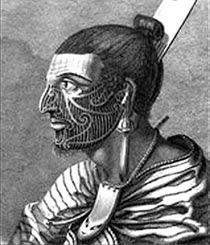
Samoa
Samoa was first settled some 3,000 years ago when people from South East Asia began to migrate towards the Pacific islands.
Samoans had gods of their own. The Samoan culture is centered around the principle of vāfealoa'i, the relationships between people. These relationships are based on respect, or fa'aaloalo. When Christianity was introduced in Samoa, most Samoan people converted. Currently 98% of the population identify themselves as Christian. The other 2 percent either identify themselves as irreligious, or do not belong to any congregation.
As with many Polynesian islands with significant and unique tattoos, Samoans have two gender specific and culturally significant tattoos. For males, it is called the tatau and consists of intricate and geometrical patterns tattooed that cover areas from the knees up towards the ribs. A male who possess such a tatau is called a soga'imiti. A Samoan girl or teine is given a malu, which covers the area from just below her knees to her upper thighs.
One area of Samoan design, which really stands out, is in the construction of Samoan fale. The roof of the building was made from a very complex arrangement of rafters and beams, bound together in a special way with rope made of sinnet. This method of construction leads to the formation of superb patterns on the inner surface of the roof.
The graphic arts seem to be equally devoid of activity with the exception of one area, that of tapa. Tapa is a material usually made from the inner bark of the paper mulberry tree. In Samoa it served as clothing, sail material and a way of expressing wealth. It was usually decorated with a reddy-brown or black pigment in intricate geometrical designs.






No comments:
Post a Comment